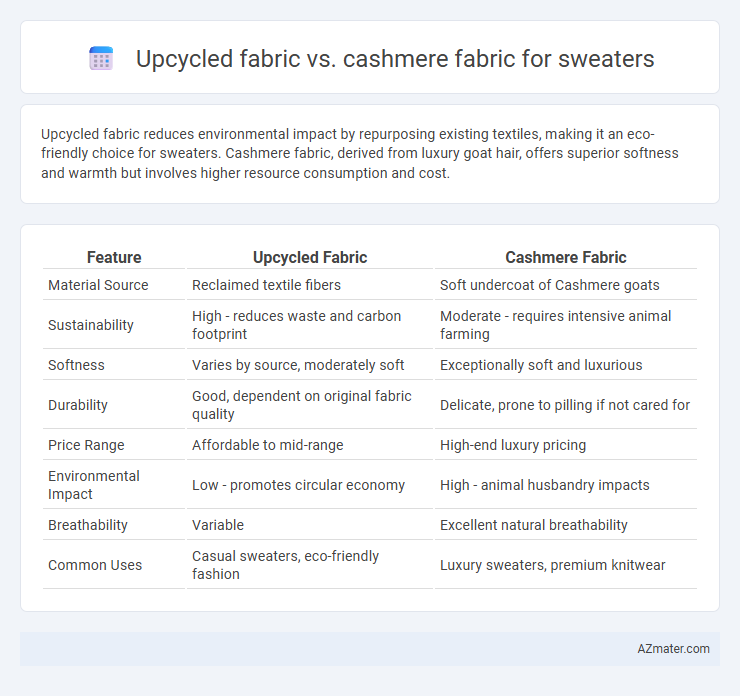Upcycled fabric reduces environmental impact by repurposing existing textiles, making it an eco-friendly choice for sweaters. Cashmere fabric, derived from luxury goat hair, offers superior softness and warmth but involves higher resource consumption and cost.
Table of Comparison
| Feature | Upcycled Fabric | Cashmere Fabric |
|---|---|---|
| Material Source | Reclaimed textile fibers | Soft undercoat of Cashmere goats |
| Sustainability | High - reduces waste and carbon footprint | Moderate - requires intensive animal farming |
| Softness | Varies by source, moderately soft | Exceptionally soft and luxurious |
| Durability | Good, dependent on original fabric quality | Delicate, prone to pilling if not cared for |
| Price Range | Affordable to mid-range | High-end luxury pricing |
| Environmental Impact | Low - promotes circular economy | High - animal husbandry impacts |
| Breathability | Variable | Excellent natural breathability |
| Common Uses | Casual sweaters, eco-friendly fashion | Luxury sweaters, premium knitwear |
Introduction to Upcycled and Cashmere Fabrics
Upcycled fabric is created by repurposing existing materials, significantly reducing waste and environmental impact compared to traditional textile production. Cashmere fabric, sourced from the soft undercoat of cashmere goats, is highly prized for its exceptional warmth, softness, and luxury. Sweaters made from upcycled fabric emphasize sustainability and unique textures, while cashmere sweaters offer unmatched comfort and premium quality.
Defining Upcycled Fabric: Process and Materials
Upcycled fabric for sweaters involves transforming pre-existing textiles, such as discarded garments or fabric scraps, into new, wearable materials, significantly reducing waste and environmental impact. The process includes sorting, cleaning, and mechanically or chemically breaking down the original fabrics before spinning them into yarn or reweaving into new textile forms. Unlike luxurious, natural cashmere derived from the undercoat of cashmere goats, upcycled fabrics prioritize sustainability and resource efficiency by repurposing existing fibers rather than relying on virgin raw materials.
What Makes Cashmere Unique?
Cashmere fabric is unique due to its luxurious softness, exceptional warmth, and lightweight feel derived from the fine undercoat hairs of Cashmere goats, primarily sourced from Mongolia and China. Unlike upcycled fabrics, which repurpose existing textiles to reduce environmental impact, Cashmere's value lies in its natural fiber quality, durability, and insulating properties that provide unmatched comfort. Its limited supply and labor-intensive harvesting process contribute to its exclusivity and higher price point compared to upcycled alternatives for sweaters.
Environmental Impact: Upcycled Fabric vs Cashmere
Upcycled fabric significantly reduces environmental impact by repurposing existing materials, lowering textile waste and minimizing resource consumption such as water, energy, and chemicals compared to virgin fibers. Cashmere fabric, derived from the undercoat of cashmere goats, often contributes to overgrazing and habitat degradation, leading to increased carbon emissions and soil erosion. Choosing upcycled fabric for sweaters supports sustainable fashion by decreasing reliance on animal farming and reducing the overall ecological footprint compared to traditional cashmere production.
Durability and Longevity: Which Sweater Lasts Longer?
Upcycled fabric sweaters often exhibit moderate durability due to the repurposed nature of materials, which can vary in quality and strength. Cashmere fabric sweaters are renowned for their exceptional softness but require careful maintenance to preserve longevity, as the delicate fibers can wear down with frequent use. Overall, while cashmere offers a luxurious feel, upcycled fabric sweaters may provide better everyday durability depending on the source material and construction.
Comfort and Softness: Wearing Experience Compared
Upcycled fabric sweaters often provide a unique texture that can vary in softness depending on the source materials, offering an eco-friendly and breathable option suitable for casual wear. Cashmere fabric excels in delivering exceptional comfort and unparalleled softness due to its fine, long fibers derived from cashmere goats, making it ideal for luxury sweaters with a plush feel against the skin. The wearing experience of cashmere typically surpasses upcycled fabrics in terms of warmth retention and smoothness, creating a cozy and indulgent sensation during use.
Cost and Accessibility: Price Differences Explored
Upcycled fabric sweaters offer significant cost savings compared to luxury cashmere, making them more accessible to budget-conscious consumers. Cashmere sweaters typically range from $200 to $1,000+ due to the high costs of raw materials and labor-intensive processing, whereas upcycled fabric garments often cost under $100. The affordability and sustainability of upcycled fabric make it an attractive alternative without compromising style or quality.
Ethical Considerations in Fabric Sourcing
Upcycled fabric for sweaters significantly reduces environmental impact by repurposing existing materials, minimizing waste and conserving resources compared to cashmere, which often involves resource-intensive goat farming associated with land degradation and animal welfare concerns. Ethical sourcing of cashmere faces challenges such as overgrazing and the exploitation of herders, whereas upcycled fabrics promote circular fashion by extending textile lifecycles and reducing carbon footprint. Choosing upcycled fabric supports sustainable practices and aligns with growing consumer demand for environmentally responsible and cruelty-free fashion options.
Style and Design Possibilities
Upcycled fabric offers unique, one-of-a-kind patterns and textures, enhancing creativity in sweater design with its sustainable, eco-friendly appeal. Cashmere fabric provides luxurious softness and a sleek, refined look, ideal for classic and elegant sweater styles. Designers leverage upcycled fabric for bold, artistic statements, while cashmere excels in timeless, high-end knitwear with smooth drape and warmth.
Final Verdict: Choosing the Right Sweater for You
Upcycled fabric sweaters offer sustainable benefits by reusing materials and reducing environmental impact, while cashmere sweaters provide superior softness, warmth, and luxury. Your choice depends on prioritizing eco-consciousness or premium comfort and durability in your wardrobe. Selecting the right sweater balances environmental values with fabric quality and personal style preferences.

Infographic: Upcycled fabric vs Cashmere fabric for Sweater
 azmater.com
azmater.com